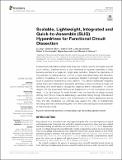Scalable, Lightweight, Integrated and Quick-to-Assemble (SLIQ) Hyperdrives for Functional Circuit Dissection
Author(s)
Liang, Li; Oline, Stefan N.; Kirk, Justin C.; Schmitt, Lukas Ian; Remondes, Miguel; Halassa, Michael M.; Komorowski, Robert; ... Show more Show less
DownloadScalable, lightweight.pdf (4.386Mb)
PUBLISHER_CC
Publisher with Creative Commons License
Creative Commons Attribution
Terms of use
Metadata
Show full item recordAbstract
Independently adjustable multielectrode arrays are routinely used to interrogate neuronal circuit function, enabling chronic in vivo monitoring of neuronal ensembles in freely behaving animals at a single-cell, single spike resolution. Despite the importance of this approach, its widespread use is limited by highly specialized design and fabrication methods. To address this, we have developed a Scalable, Lightweight, Integrated and Quick-to-assemble multielectrode array platform. This platform additionally integrates optical fibers with independently adjustable electrodes to allow simultaneous single unit recordings and circuit-specific optogenetic targeting and/or manipulation. In current designs, the fully assembled platforms are scalable from 2 to 32 microdrives, and yet range 1–3 g, light enough for small animals. Here, we describe the design process starting from intent in computer-aided design, parameter testing through finite element analysis and experimental means, and implementation of various applications across mice and rats. Combined, our methods may expand the utility of multielectrode recordings and their continued integration with other tools enabling functional dissection of intact neural circuits.
Date issued
2017-02Department
Picower Institute for Learning and MemoryJournal
Frontiers in Neural Circuits
Publisher
Frontiers Research Foundation
Citation
Liang, Li; Oline, Stefan N.; Kirk, Justin C.; Schmitt, Lukas Ian; Komorowski, Robert W.; Remondes, Miguel and Halassa, Michael M. “Scalable, Lightweight, Integrated and Quick-to-Assemble (SLIQ) Hyperdrives for Functional Circuit Dissection.” Frontiers in Neural Circuits 11 (February 2017): 8 © 2017 Liang, Oline, Kirk, Schmitt, Komorowski, Remondes and Halassa
Version: Final published version
ISSN
1662-5110